The massacre of Monte Arruit took place on 9 August 1921 in Al Aaroui during the Rif War, when, after the July 1921 Battle of Annual, Riffian forces slaughtered most of the Spanish soldiers who had surrendered on that day.
The massacre of Monte Arruit took place on 9 August 1921 in Al Aaroui during the Rif War, when, after the July 1921 Battle of Annual, Riffian forces slaughtered most of the Spanish soldiers who had surrendered on that day.
The Riffians forces advanced quite rapidly into a number of positions following the crushing defeat of the Spanish forces at the 22 July 1921 Battle of Annual and by early August they had already taken Zeluán and Nador. [1] General Felipe Navarro had retreated to Arruit on 29 July, [2] with around 2,201 ready soldiers and 252 wounded, joining the garrison of 964 soldiers. [3]
After 12 days of siege, [n. 1] General Navarro was allowed to negotiate surrender terms. [4] He agreed on 9 August on the delivering of the weapons in exchange for free passage. [4] However, the Riffians failed to honor the agreement (either from treason from the Riffian leaders who had negotiated the terms or revolt by the disgruntled low-rank Riffians) [5] and most of the remaining Spanish soldiers (over 2,000) [6] were slaughtered on that day after the capitulation. [4] About 400 (or 600), [7] mostly officers—including General Navarro—were spared to be held for ransom. [4]
The Riffian forces disobeyed orders from Abd el Krim who had extolled the good treatment of prisoners and wounded. [5]
Once after the process for recapture of the Spanish territory lost after Annual began on 10 October 1921, the troops led by General Sanjurjo who secured the position of Monte Arruit on 24 October were overcome by the rotting stench of the corpses. [8]
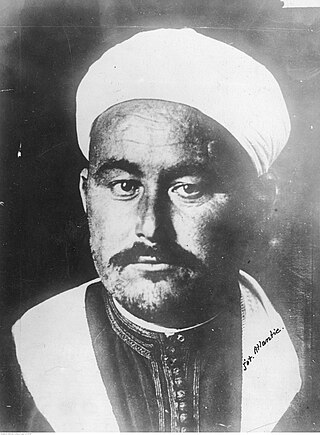
Muhammad ibn Abd al-Karim al-Khattabi, better known as Abd el-Krim, was a Moroccan political and military leader and the president of the Republic of the Rif. He and his brother M'Hammad led a large-scale revolt by a coalition of Riffian tribes against the Spanish and French Protectorates of the Rif and the rest of Morocco. His guerrilla tactics, which included the first-ever use of tunneling as a technique of modern warfare, directly influenced Ho Chi Minh, Mao Zedong and Che Guevara. He also became one of the major figures of Arab nationalism, which he actively supported.
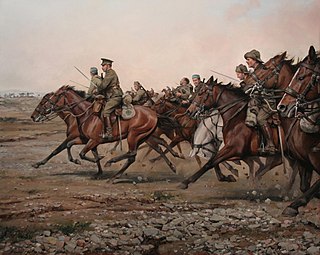
The Battle of Annual was fought on 22 July 1921 at Annual, in northeastern Morocco, between the Spanish Army and Rifian Berbers during the Rif War. The Spanish suffered a major military defeat, which is almost always referred to by the Spanish as the Disaster of Annual which is widely considered to be the worst defeat suffered by the modern Spanish Army.

The Republic of the Rif was a confederate republic in the Rif, Morocco, that existed between 1921 and 1926. It was created in September 1921, when a coalition of Rifians led by Abd el-Krim revolted in the Rif War against the Spanish protectorate in Morocco. The French would intervene on the side of Spain in the later stages of the conflict. A protracted struggle for independence killed many Rifians and Spanish–French soldiers, and witnessed the use of chemical weapons by the Spanish army—their first widespread deployment since the end of the World War I. The eventual Spanish–French victory was owed to the technological and manpower advantages despite their lack of morale and coherence. Following the war's end, the Republic was ultimately dissolved in 1926.

The Rif or Riff, also called Rif Mountains, is a geographic region in northern Morocco. It is bordered on the north by the Mediterranean Sea and Spain and on the west by the Atlantic Ocean, and is the homeland of the Rifians and the Jebala people. This mountainous and fertile area is bordered by Cape Spartel and Tangier to the west, by Berkane and the Moulouya River to the east, by the Mediterranean to the north, and by the Ouergha River to the south. The Rif mountains are separated into the eastern Rif mountains and western Rif mountains.
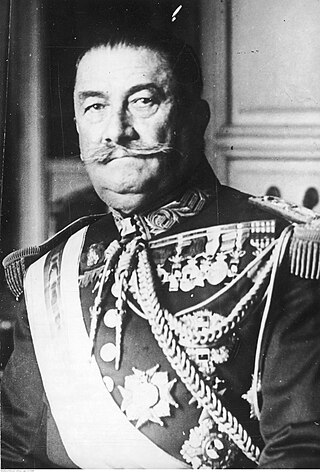
Dámaso Berenguer y Fusté, 1st Count of Xauen was a Spanish general and politician. He served as Prime Minister during the last thirteen months of the reign of Alfonso XIII.
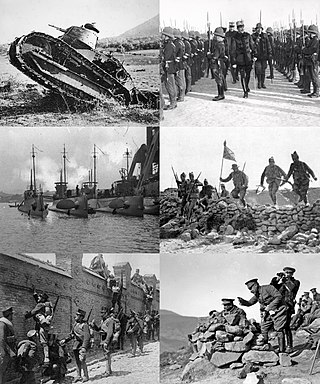
The Rif War was an armed conflict fought from 1921 to 1926 between the occupying colonialists of Spain and the Berber tribes of the mountainous Rif region of northern Morocco. The Rif Republic alone was able to keep a European middle power and great power in check for a time.
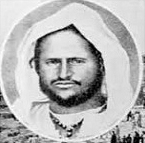
Amghar Sharif Mohammed Ameziane was a Qaid (Amghar) of the Rif Tribes and the main figurehead of the Riffian resistance against the Spanish Protectorate of Morocco before Abd el-Krim.

General Miguel Primo de Rivera's dictatorship over Spain began with a coup on 13 September 1923 and ended with his resignation on 28 January 1930. It took place during the wider reign of King Alfonso XIII. In establishing his dictatorship, Primo de Rivera ousted the liberal government led by Prime Minister Manuel García Prieto and initially gained the support of King Alfonso XIII and the army. During the Military Directory (1923–1925), the dictatorship created the official party of the regime, the Unión Patriótica (UP). It also censored the Spanish press and worked to eliminate separatism in Catalonia. Under Primo de Rivera's dictatorship, Spain won the Rif War, where Spanish forces fought Riffian tribes in Morocco.

The Second Melillan campaign was a conflict in 1909 in northern Morocco around Melilla. The fighting involved local Riffians and the Spanish Army.

Manuel Fernández Silvestre was a Spanish general.

Manuel Goded Llopis was a Spanish Army general who was one of the key figures in the July 1936 revolt against the democratically elected Second Spanish Republic. Having unsuccessfully led an attempted insurrection in Barcelona, he was captured and executed by the Republican government. Previously, Goded had distinguished himself in the Battle of Alhucemas of the Rif War.
Captain Félix Arenas Gaspar, a Puerto Rican, was a captain in the Spanish Army who was posthumously awarded the Cruz Laureada de San Fernando for his actions in the Rif War.

The Alhucemas landing was a landing operation which took place on 8 September 1925 at Alhucemas by the Spanish Army and Navy and, in lesser numbers, an allied French naval and aerial contingent, that would put an end to the Rif War. It is considered the first amphibious landing in history involving the use of tanks and massive seaborne air support. Alhucemas is seen as a precursor of the Allied amphibious landings in World War II, and the first successful combined operation of the 20th century.

The National Defence Council was the governing body in Republican Spain at the end of the Spanish Civil War (1936–1939). The council seized power with Colonel Segismundo Casado's coup on 5 March 1939 when it was clear that the Republicans had lost the war. The leaders hoped to negotiate an end to hostilities with the rebel forces led by General Francisco Franco. However, Franco insisted on unconditional surrender, and on 26 March 1939 launched the final offensive of the Spanish Civil War. By the end of the month he controlled the whole country. Most of the council members escaped into exile on British warships.
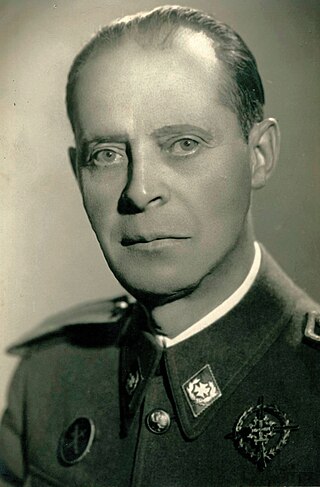
Manuel Ruigómez y Velasco was a Spanish Army officer known for his role as a medical officer in the Rif War, during the period of Colonial Africa. In 1919, he was awarded the Laureate Cross of Saint Ferdinand, Spain's highest decoration for gallantry.

Fernando Primo de Rivera y Orbaneja was a Spanish soldier, brother of the dictator Miguel Primo de Rivera y Orbaneja and uncle of Falange’s founder José Antonio Primo de Rivera.
Ait Oulichek is an Amazigh Riffian tribe located in the North-Eastern province of Morocco. Ayt or Beni is referred to as 'Descendants of' with the latter being the most common form of address of the Oulichek tribe until the recent Arabization in Morocco initiative.
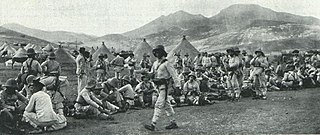
The Kert campaign was a conflict in northern Morocco between Spain and insurgent Riffian harkas led by Mohammed Ameziane, who had called for a jihad against the Spanish occupation in the eastern Rif. It took place between 1911 and 1912.
Abd el-Kader bel Hach Tieb was a Riffian tribal leader, caïd of the Beni Sicar, in northeastern Morocco.
Eliseo Álvarez-Arenas Romero was a Spanish military officer who participated in the Rif War and the Spanish Civil War, commanding several military units. During the Francoist regime he held important positions, being Director General of the Civil Guard between 1939 and 1942.